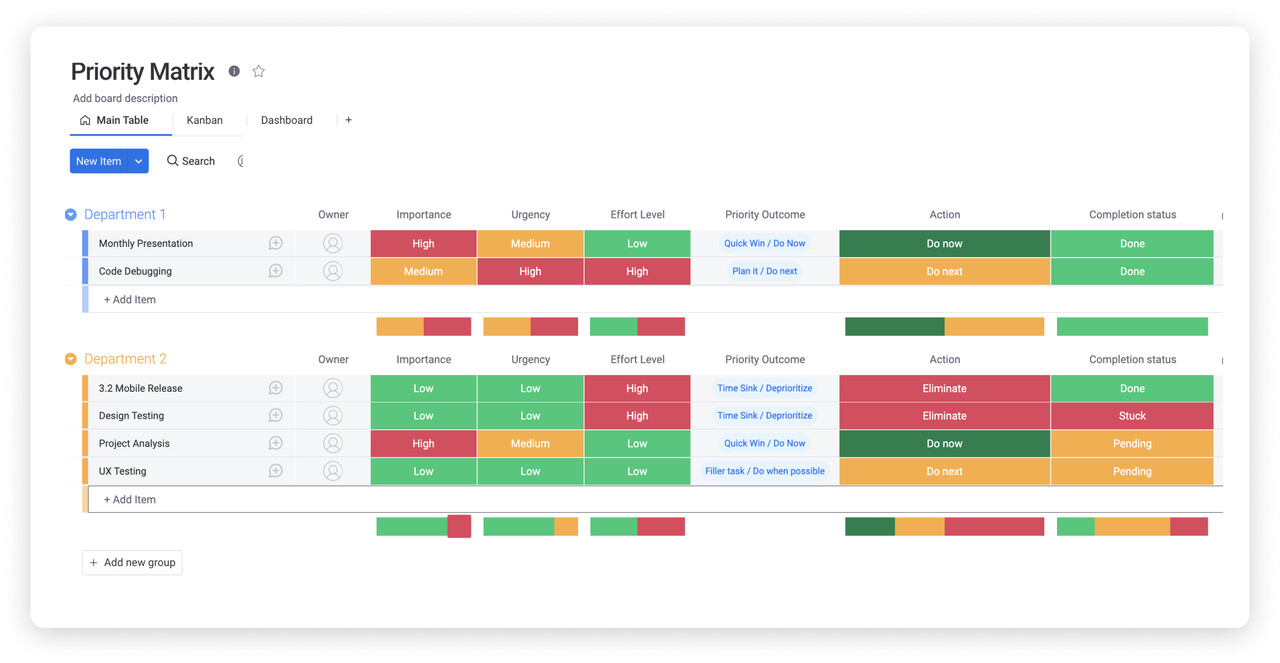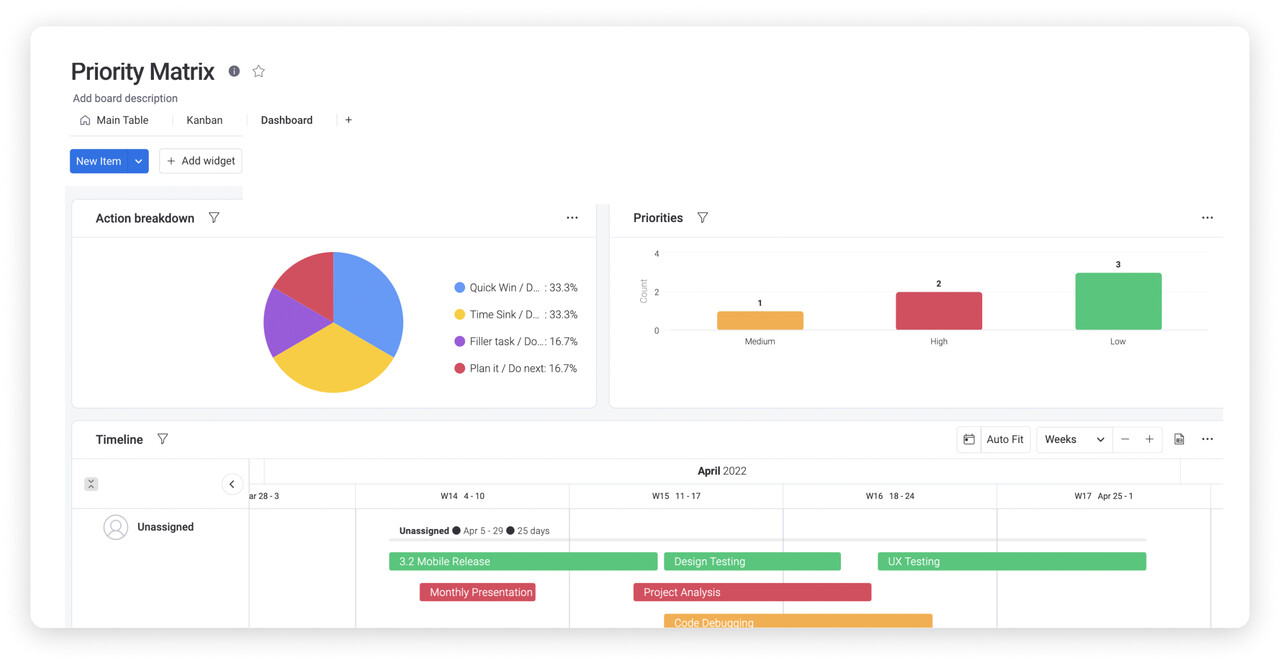There are countless examples of famous decision-makers that relegated their wardrobes to one or two simple outfits. Steve Jobs was rarely seen without his signature black sweater and blue jeans. The same goes for Mark Zuckerberg’s grey T-shirts. And even Barack Obama chose to simplify his wardrobe. While some people suspect these leaders’ stylistic choices were personal branding, the real reason is much more practical.
You don’t need to lead the free world to realize that every decision you make uses up time and mental energy, which is why intelligent people simplify and systemize their choices.
In this article, we’ll take a deep dive into decision-making systems by looking at a few popular examples of them and how they work. We’ll also look at monday.com’s decision-making templates and demonstrate how they can help you think clearly and choose wisely. But first, let’s explain why you’d want to use a decision-making template in the first place.
Why use a decision-making template?
Most people are familiar with writing a pros and cons list. This is a decision-making template in its simplest form. You write the decision at the top, draw two columns, and put the pros on one side and the cons on the other. But in the business world with project deadlines and budget constraints, a list of pros and cons rarely suffices. Stakeholders need systems and templates that help them make clear, accurate, and informed decisions.
Put simply, a decision-making template is a tool to help you simplify complex decisions, narrow down your options, and identify which criteria matter most.They’re also useful after you’ve already made a decision. A decision-making matrix can help you validate your decision by looking at the potential outcomes of that decision and the likelihood of those outcomes occurring. This can demonstrate whether your decision produced the desired results given the information you had at the time. Moving away from abstract definitions of the decision process, let’s see how these ideas work in the real world by way of examples.
What are some examples of decision-making processes and templates?

Common decision-making processes include grid analysis, cost-benefit analysis, and decision tree analysis. For project management, here are a few of the tried and true processes:
Decision tree analysis
A decision tree is a graphical representation of a set of decision rules and a type of workflow chart. The tree is composed of nodes, which represent either a decision or a chance event, and branches, which represent the possible outcomes of a decision or chance event. You can use decision trees to predict outcomes based on a series of decisions or chance events. By evaluating each potential outcome, you can determine the course of action with the overall best outcome.
Grid analysis
Grid analysis is a technique used for making decisions by evaluating a grid of options presented in a table format with each row representing a different option and each column representing a different criterion. The options are then evaluated according to the criteria and the option with the best overall score is chosen. The process works as follows:
- Choose a topic or problem to analyze.
- Break the topic or problem down into smaller pieces.
- Create a grid with rows and columns.
- In the rows, list the smaller pieces from the second step.
- In the columns, list the different factors or elements you want to analyze.
- For each row, analyze the different factors in the columns.
- Draw conclusions based on your analysis.
Visualizing the decision-making process
In most cases, decision-making techniques are visual tools. By visualizing data and information through tables, boards, charts, and diagrams, it’s easier to understand relationships and patterns between decisions that might otherwise go unnoticed. Data in text and numeric form can only get you so far — on the other hand, visualization is beneficial because it can help people make decisions more quickly and easily and avoid decision paralysis.
It can also help people understand complex information more clearly. In addition, visualization can help people remember information better. In other words, applying decision-making techniques with premade templates not only helps the overall process, but you’ll save even more time by using a tool that’s ready to go when you are.
Decision-making template on monday.com

With monday.com’s easy-to-use yet powerful task boards, prioritizing tasks to better manage your time is impossibly easy. With a few clicks, determine which tasks require your immediate attention and which ones you should delegate. Use color coding built into every board to easily visualize priorities and add linked outcomes so you know how each task impacts the entire project with a single click. In addition to facilitating better decisions, monday.com’s Work OS eases the entire project management process with:
- Centralized data: As a data hub, monday.com shares data across all your projects and dashboards, letting you share tasks, activities, files, projects, and decisions with the entire team — all from your tools, all in real time.
- Performance monitoring: See how your decisions pan out by monitoring the performance of every task and activity from intuitive, customizable task boards. Plus, you choose which metrics are important to you.
- Built-in automation: Once decisions are made and tasks are assigned, project progress flows seamlessly with integrated automation that notifies team members when tasks are completed and the next one is due.
Whether it’s a decision-making or project management template, every taskboard on monday.com is easily sharable with the entire team. And with a single click, every team member can view tasks and make decisions in a way that works best for them, whether it’s a Kanban board or a dashboard with charts.
Related templates on monday.com
monday.com has dozens of customizable, premade templates that are ready to go at the click of a button and we’re always releasing new ones. Here are just a few that can help you streamline your decision-making process:
Eisenhower matrix template
This Eisenhower Matrix Template is a great way to prioritize tasks and figure out what’s most important. It’s named after President Dwight D. Eisenhower, who reportedly used this method for his own tasks. The Eisenhower matrix has four quadrants:
- Urgent tasks: These tasks should be done immediately. These are usually things like deadlines and emergencies.
- Not urgent tasks: These are tasks that can be scheduled for later but are still important. These include things like planning and goal-setting.
- Urgent but not important tasks: These are the tasks that you should delegate to someone else. These are time-sensitive but not important such as certain email requests.
- Not urgent and not important tasks: Eliminate these tasks. These are things that are neither time-sensitive nor important such as distractions, busy work, or deciding on a presidential wardrobe.
Cost-benefit analysis template
When project managers need to know the variables between a project’s strengths and weaknesses, they use cost-benefit analysis to inform their decision. Take the mystery out of getting started on a cost-benefit analysis with monday.com’s Cost-Benefit Analysis Template. With a few clicks, project managers can parse and identify a project’s strengths and weaknesses, determine project viability by comparing cost projections, and identify any pitfalls that can help inform their decision. Additionally, with a click of a button, they can create a visual dashboard of the cost-benefit balance to share with the whole team.
Frequently asked questions
Making good decisions requires experience and depth of knowledge. With that in mind, here are a couple of answers to common questions about the science of decision-making.
What is a decision matrix?
A decision matrix is a tool used to help make decisions by considering multiple options and criteria. It’s used to compare choices, identify pros and cons, or choose the best option. The grid analysis listed above is a type of decision matrix.
How are matrices used in business?
Matrices are used in business to help simplify and organize data and enable more efficient and effective decision-making. For example, a team might use a matrix to track sales data over time. This would help the company see patterns and trends in customer behavior. Matrices can also be used to track production levels and time management which can help optimize efficiency and improve operations.
Make your job easier by systemizing your decisions
Successful projects are filled with tough decisions throughout their entire life cycle. Making trade-offs and prioritizing is part of the job when it comes to seeing a project through to completion whether you’re the project manager or a team member. But you can make all those decisions considerably easier by systemizing them and thoughtfully weighing your options with a decision-making template. It may not help you choose what to wear on casual Friday, but it’ll sure help you make better business decisions.

